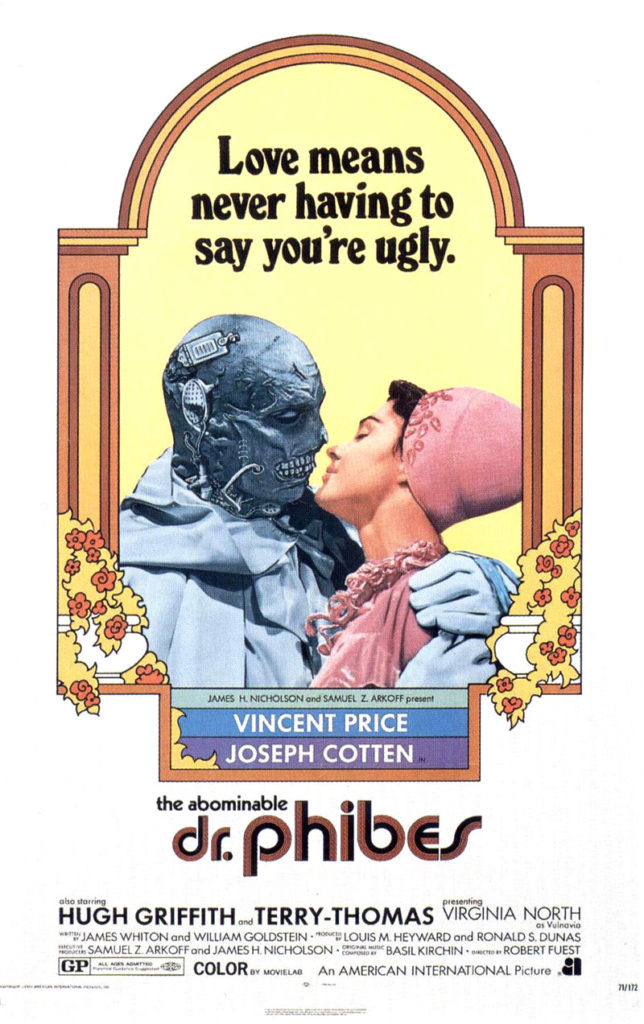Vincent Price has been woefully underrepresented here in the Horrorshow, but partial restitution will be made today. Vincent Price may have spent much of his career far from the glitz and glam of big Hollywood, but that wasn’t because of a lack of skill as an actor.
Vincent Price was a bit of a rollicking performer. It didn’t matter how silly the role or the movie. In fact, the more absurd a project, the more Price seemed to enjoy what he was doing. Sometimes actors are the victims of typecasting, but in the case of Vincent Price, he thrived. Today’s film features one of Price’s most iconic roles — that of the hideously disfigured Dr. Anton Phibes.
From 1971, The Abominable Dr. Phibes, from director Robert Fuest, is a horror film that is almost an off-Broadway play in disguise. Despite being a horror film, it has no scares. This gets down to the root philosophy of horror cinema. If a horror film is not frightening, and was never intended to be, is it still horror? I maintain that yes, it is. Horror is more than just scares. It is setting, theme, plot, and everything else from funhouse garishness to unsettling dread. This film is very much the former.
As it opens, a viewer is treated to Dr. Phibes playing an organ as it rises from beneath the stage (for it really does appear that we are watching a stage production). This set is Dr. Phibes’s lair, one that is perfectly at home among those found in comic books or in the many interpretations of The Phantom of the Opera. As we all know, no evil genius can commence their dastardly machinations without having the lair squared away. Imagine if the hero were to arrive to vanquish the villain and there were still cans of paint resting on the floor among canvas drop cloths and ladders. No, interior design is an essential element of any evil genius’s plan.
There’s nary a word of dialogue for the first ten minutes of the film, and it works to establish the bizarre pageantry of Dr. Phibes. Whatever has made him the way he is, it has instilled in him a sense of the dramatic.
Dr. Phibes is an American International  Pictures release, which means it was likely to be a piece of crap. But this opening scene, followed by Dr. Phibes’s first kill, separates it completely from other such AIP flicks as I Was a Teenage Werewolf and The Amazing Colossal Man. That isn’t a knock on either of those films. They’re quite enjoyable to those who, like me, are into shitty movies. But Dr. Phibes isn’t a shitty movie. It’s damn good fun.
Pictures release, which means it was likely to be a piece of crap. But this opening scene, followed by Dr. Phibes’s first kill, separates it completely from other such AIP flicks as I Was a Teenage Werewolf and The Amazing Colossal Man. That isn’t a knock on either of those films. They’re quite enjoyable to those who, like me, are into shitty movies. But Dr. Phibes isn’t a shitty movie. It’s damn good fun.
But, why is Dr. Phibes killing people?
Well, it turns out that Dr. Phibes is having his vengeance on a group of doctors whom he holds responsible for the death of wife while she was in surgery. Rather than just kill these men with knife or pistol, Dr. Phibes uses an interpretation of the ten plagues of Egypt. He drops bats and locusts onto his victims. One death, a quite liberal interpretation of the plagues, involves garroting someone with a frog mask.
The film follows a pattern. Dr. Phibes kills, and then we viewers see him in his lair, either playing his organ or addressing a portrait of his dead wife. These soliloquys are absurdist horror gold, especially since Price doesn’t move his mouth while saying them. What? That’s right. Price’s lines are all recorded, and he mimics them while they are being played. Dr. Phibes’s face is a mask, and his character has invented a way to emit his vocalizations through the horn of an old phonograph. It’s neat and about as creepy as the film gets. The only drawback is that we never get to see Price smile. We can tell this is one of those films where Price was enjoying himself, but we never get to see that. Oh, well.
Price has been in enough classic horror flicks that I could spend the entire Horroshow reviewing his films. This is one that any reader who is into horror should seek out. It’s a departure from the shock and gore of modern horror, hailing from a time when the counterculture still held sway. It may be a relic from a time when films could laugh in the face of realism, but that’s what makes it great.
